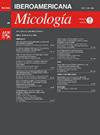当前临床指南对侵袭性真菌疾病管理的影响。
IF 1.6
4区 生物学
Q4 MYCOLOGY
引用次数: 0
摘要
Isavuconazole是一种新型广谱抗真菌三唑类药物,与其他唑类药物相比,在药物相互作用、不良反应和耐受性方面具有更好的安全性。越来越多的证据支持isavuconazole治疗侵袭性真菌疾病的有效性。在这篇综述中,我们旨在分析这一新证据对主要临床指南的影响。我们回顾了全球主要传染病学会发布的最新共识指南,重点介绍了关于在不同侵袭性真菌感染和管理策略中使用异戊康唑的建议的新颖性。依沙乌康唑已被列入侵袭性曲霉病的一线治疗,根据临床情况,对伏立康唑或依沙乌康唑的偏好略有不同。在毛霉病中,isavuconazole被认为是替代两性霉素B脂质体的一线治疗方法,特别是对于那些有潜在肾功能损害的患者。此外,对于这两种情况,建议在抢救情况下使用异戊康唑,并考虑与其他霉菌活性药物联合使用。该指南报告了使用该药物治疗由其他霉菌和罕见酵母引起的真菌病以及地方性真菌病所取得的令人鼓舞的结果,但由于仍然缺乏确凿的证据,该领域的建议通常是薄弱的。Isavuconazole是侵袭性真菌感染的一种合适的治疗选择,对包括曲霉和真菌在内的一系列病原体都有疗效。在某些情况下,其安全性和良好的药物相互作用使其成为伏立康唑或两性霉素B脂质体等传统药物的有价值的替代品。然而,为了更好地了解其在联合治疗中的作用并评估其对其他真菌物种的有效性,继续研究是必不可少的。本文章由计算机程序翻译,如有差异,请以英文原文为准。
Impact of current clinical guidelines on the management of invasive fungal disease
Isavuconazole is a new broad-spectrum antifungal triazole with a better safety profile in terms of drug–drug interactions, adverse effects, and tolerance compared to other azoles. Increasing evidence supports the usefulness of isavuconazole in the treatment of invasive fungal diseases. In this review, we aim to analyze the influence of this new evidence on the main clinical guidelines. We reviewed the most recent consensus guidelines issued by the major infectious diseases societies worldwide, focusing on the novelties regarding the recommendations for the use of isavuconazole in different invasive fungal infections and management strategies.
Isavuconazole has been included as first-line therapy for invasive aspergillosis, with slight differences in preference for voriconazole or isavuconazole depending on the clinical scenario. In mucormycosis, isavuconazole is considered an alternative first-line therapy to liposomal amphotericin B, especially in those patients with underlying renal impairment. Additionally, the use of isavuconazole is suggested in salvage scenario for both conditions, and the combination with other mold-active drugs is considered. The guidelines report the promising results obtained with the use of this drug for treating mycoses caused by other molds and rare yeasts, as well as endemic mycoses, but since solid evidence is still lacking, the recommendations in this area are generally weak.
Isavuconazole is a suitable therapeutic option for invasive fungal infections, offering efficacy against a range of pathogens, including Aspergillus and fungi within the order Mucorales. Its safety profile and its favorable drug interaction profile make it a valuable alternative to traditional agents like voriconazole or liposomal amphotericin B in certain scenarios. However, continued research is essential to better understand its role in combination therapies and to assess its effectiveness against other fungal species.
求助全文
通过发布文献求助,成功后即可免费获取论文全文。
去求助
来源期刊

Revista Iberoamericana De Micologia
MYCOLOGY-
CiteScore
1.90
自引率
0.00%
发文量
17
审稿时长
81 days
期刊介绍:
Revista Iberoamericana de Micología (Ibero-American Journal of Mycology) is the official journal of the Asociación Española de Micología, Asociación Venezolana de Micología and Asociación Argentina de Micología (The Spanish, Venezuelan, and Argentinian Mycology Associations). The Journal gives priority to publishing articles on studies associated with fungi and their pathogenic action on humans and animals, as well as any scientific studies on any aspect of mycology. The Journal also publishes, in Spanish and in English, original articles, reviews, mycology forums, editorials, special articles, notes, and letters to the editor, that have previously gone through a scientific peer review process.
 求助内容:
求助内容: 应助结果提醒方式:
应助结果提醒方式:


